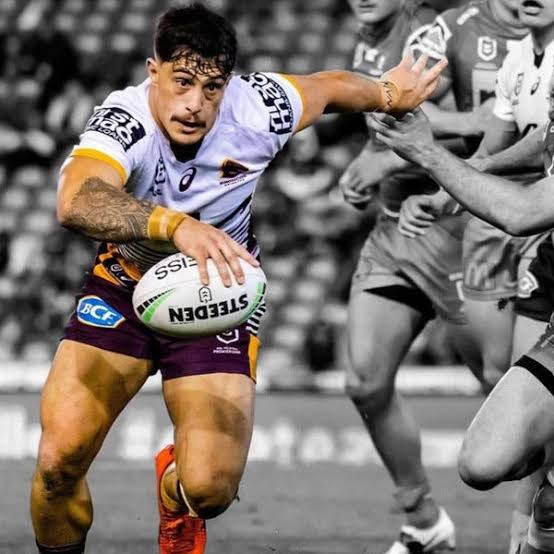—
Bronco in the Big Apple: The Kotoni Staggs Story
In a historic moment in NRL history, Kotoni Staggs became the only Brisbane Broncos superstar to secure a mansion in New York City at the age of 26. It wasn’t just a story of wealth—it was the tale of a young man from Wellington, New South Wales, who defied all odds, pushed past injuries, criticism, and the confines of rugby league’s traditionally Australian bubble to become a global icon.
Staggs stood on the balcony of his Upper West Side brownstone mansion, gazing across Central Park as the sun set over the Manhattan skyline. The scene was surreal—his jersey framed behind him, the bronco emblem catching the golden glow of dusk. The same jersey he’d worn in the 2024 NRL Grand Final when he’d scored the match-winning try in golden point extra time. That moment had gone viral, not just in Australia, but globally.
It wasn’t just the try—it was how he’d roared into the camera afterward, eyes blazing, voice cracking as he shouted, “This is just the beginning!”
And it was.
Back then, few could have imagined what would follow. The NRL wasn’t exactly on the radar in America. Sure, there were expansion talks, a few exhibition games, and the occasional crossover athlete. But when Staggs’ name started trending on U.S. social media—thanks to a behind-the-scenes documentary that aired on Netflix called “Rumble Down Under”—everything changed.
The series painted him as the NRL’s anti-hero: fierce, raw, vulnerable. Viewers were captivated by his story. A boy from a small Australian town with Tongan roots, raised by a single mother, with dreams bigger than the stadiums he played in. His battles with injury, his explosive style of play, his unapologetic personality—Americans loved it. They didn’t just want to watch him; they wanted to know him.
When Netflix offered him a consulting role on a new sports drama series called “The Fifteenth Man”, he took the leap, flying to New York during the Broncos’ offseason. The series—loosely based on his life—was a smash hit. Soon, Staggs was being invited to red carpets, courtside at Knicks games, guest spots on Fallon and Saturday Night Live. He even featured in a Super Bowl commercial for a major sneaker brand, where he tackled a CGI kangaroo in the middle of Times Square.
The mansion deal followed shortly after.
“People think it’s about the money,” Staggs had told GQ Australia during an interview conducted in his marble-tiled foyer. “But for me, it’s about showing the next kid from a small town that you don’t have to stop dreaming just because people stop believing.”
And the house? Oh, it wasn’t just any New York mansion. This was a five-story architectural marvel, once owned by an eccentric tech billionaire, retrofitted with a private gym, a rugby training simulator, and a rooftop pool with a retractable glass ceiling. On the basement level, there was a recording studio where Staggs collaborated with local artists under the pseudonym “K. Blaze,” dropping spoken-word tracks that merged rugby slang with hip-hop rhythms.
His closest mates from Brisbane would fly over during the off-season. Adam Reynolds had once jokingly tried to start a Vegemite café in SoHo with Staggs as a silent partner—it failed within three months, but the tale added to the legend. Reece Walsh had filmed a viral TikTok dancing shirtless in front of the mansion, sparking rumors of a “Broncos boy band” (mercifully never realized).
But not everyone was on board with Staggs’ New York venture.
NRL traditionalists accused him of turning his back on the sport. “He’s gone Hollywood,” they said. “Lost the mongrel.” But Staggs silenced all critics during the 2025 State of Origin series. He’d flown back in from the U.S., barely off the plane, and still dropped a hat-trick in Game 2, tackling like a madman and barking orders with his trademark intensity. Queenslanders chanted his name long after the final whistle.
In the same year, he helped broker a partnership between the NRL and the NFL, resulting in the first-ever NRL showcase at MetLife Stadium. With over 50,000 in attendance and millions watching online, the event was a cultural milestone. Staggs, naturally, was the headline act.
By the time he turned 26, his brand was worth more than any other rugby league player in history. Yet, when asked what moment stood out the most in his meteoric rise, he didn’t mention the money, the fame, or even the mansion.
“It was when I flew my mum to New York,” he said in a candid moment on a late-night talk show. “She’d never been on a plane that far. First time seeing snow. First time seeing the Statue of Liberty. She cried on the steps of this house—not because it was big or fancy—but because she remembered the boy who used to kick a footy against the fence every afternoon till the sun went down.”
And that’s what defined Kotoni Staggs in the eyes of his fans—heart. Beneath the bravado, the media storm, and the international flair, he was still the kid from Wellington. Still the center who hit like a truck, ran like a cheetah, and celebrated like it was always his last game.
So yes, the mansion in New York was historic. A symbol. A statement. But more than that, it was a window into a future where NRL players could be more than just athletes confined to the southern hemisphere.
It was the proof that even the toughest of games could birth global stars. That a bronco could run wild not just on Australian soil, but in the concrete jungle of Manhattan.
And as Staggs leaned against the balcony railing, hearing the faint hum of traffic below, his phone buzzed. A message from his Broncos coach.
“Preseason starts in two weeks. You in?”
Staggs grinned.
“Always.”









